I’ll introduce 2 frameworks to assess how people respond to their work demands. The first one is by the notable Positive Psychologist Mihaly Csikszentmihalyi and the second one is my own framework.
Let me first define what emotional activation is.
Employees & employers and contractors & clients – they all have their regular work to do and a whole lot of interaction and dynamic changes while completing the work. These changes produce multiple emotional states. But these states are not pure feelings. They are more like emotional behaviors. They are the opposite of being in an autopilot state.
Emotional activation is when a specific aspect of work suddenly changes your normal work routine into something that either demands a lot of mental resources or doesn’t use your mental resources. It is all those positive and negative states where emotions are hurting or helping work.
Emotion behaviors get activated any time – before a meeting, during a meeting, while completing a report, doing R&D, debugging a grave problem, etc. There is an assumed baseline feeling about work. Anything that deviates from that baseline is an activated emotion.
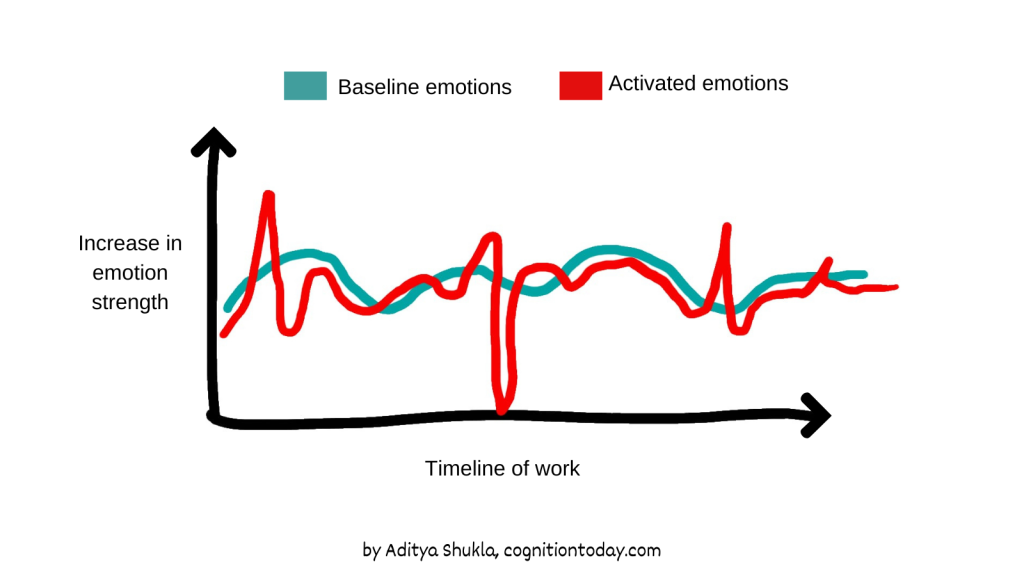
The baseline emotions are set by your typical routine day, your daily energy levels, your state of hunger & drowsiness, your preference for mornings or evenings, your typical social engagements, etc.
The activated emotions come from unusual changes.
Let’s look at the routine of an employee in a health-tech start-up.
Enter the office by 8 am. Greet co-workers. Login to your portals. Open documents you’ve been working on. Respond to work messages. Make coffee. Have all hands at 11 am. Banter and discuss problems. Eat. Return to work and start working on new ideas. Multi-task and continue working on pre-set tasks. Make coffee again. Put headphones on and continue working. Get interrupted about 2 times every hour. Continue finishing tasks. Scroll Instagram. Continue working and planning the rest of your day. Pack up and leave.
Let’s say this has a rough emotion pattern of stress-normal-stress-irritated-stress-energetic-normal-relaxed.
Let’s also assume this is a situation you’ve gotten used to because of all the problems in your product and uncertainty in revenue. Let’s also assume you are doing the job of 2-3 people and desperately need more assistance.
Imagine a more structured job routine now. That of a floor manager who greets customers and participates in sales & billing in an eyewear store.
Every day could be regimented. Fixed lunch break. Uniform. Fixed co-worker. Typical rush hour. Etc. In such cases, boredom can set in. But emotions can still get activated because of sales. Broken infrastructure. Budget cuts. Heavy rains prevent customers from walking in. Power cuts, etc.
Your activated emotions will emerge from taking on new tasks, suddenly increasing social interactions, finishing up a project and starting something very easy/difficult, having to upskill, begin reporting to new co-workers/management, your devices getting upgraded, etc. These changes dramatically put a burden on your skills and change the challenges you feel. They also change how your mood changes.
Using this as a context, let’s explore 2 frameworks that create insight into these activated emotions. The first framework describes the baseline emotions more strongly. The second framework describes the activated emotions more strongly. But both frameworks can be applied to a specific day, a single task, or a whole project at large.
Experience fluctuation chart (XP of 8)
The chart below describes 8 emotional experiences a worker will go through based on their skill and the challenge posed by the task’s demand.
This framework is an outcome framework that answers the question – How does a worker feel about work with {Skill level} when work is {Work challenge level}?
{Skill level} will vary between incompetent to expert.
{Work challenge level} will vary between extremely easy and mundane to very difficult.
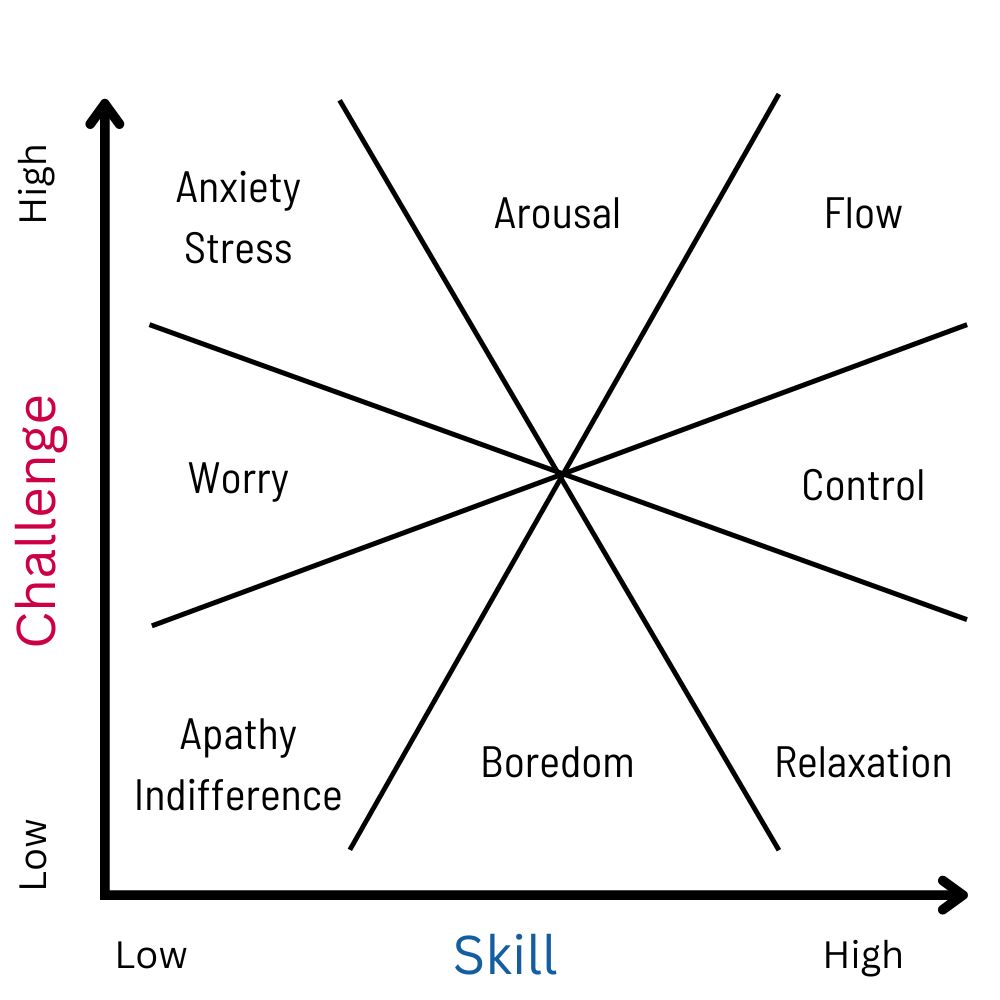
Each of the 8 experiences is based on a combination of your current skill level and the challenge you experience at work. From an employee perspective, this defines the mood and gives an idea of what must change to make work more likable. From an employer’s point of view, the chart tells us what needs to change for employees to feel more invested and act more productively.
| Mood | Challenge | Skill | Productivity |
|---|---|---|---|
| Apathy/Indifference | Low | Low | Low |
| Worry | Medium | Low | Low |
| Anxiety/Stress | High | Low | Low/Moderate |
| Boredom | Low | Medium | Low |
| Neutral/typical (not in the chart) | Medium | Medium | Moderate/typical |
| Arousal | High | Medium | High |
| Relaxed | Low | High | Low |
| Control | Medium | High | High |
| Flow | High | High | High |
- Apathy/Indifference: Work feels meaningless and unstimulating. This is also when a person feels heavily distracted because the work itself is not attention-grabbing enough.
- Worry: There is mild concern about doing work, but usually manageable. Stress from management and the environment also adds to this.
- Anxiety/Stress: Work difficulty causes stress based on a self-evaluated lack of skill, including self-esteem issues and low confidence. Physical symptoms of stress, mental health problems, and burnout occur here, leading to other problems like hating the job (or task). The work environment is also a large contributor here, but that’s a different story.
- Boredom: Demotivated or negative feelings around work; person wishes to avoid this as much.
- Arousal: High enthusiasm for work and high engagement.
- Relaxed: Work feels easy but unstimulating.
- Control: Truly manageable with feelings of achievement. There is curiosity, progress, and motivation here.
- Flow: Intense state of focus and engagement with a task with happy feelings. More about flow and how to achieve it here.
Quick highlights
If the challenge is high and your skill is low, you experience worry, stress, and anxiety. This is a gateway to procrastination and distractibility because procrastination is about avoiding stress and improving mood.
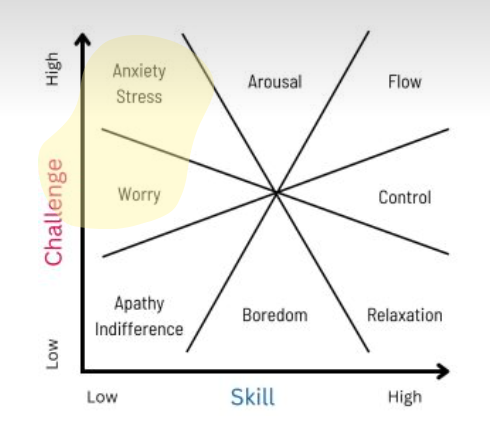
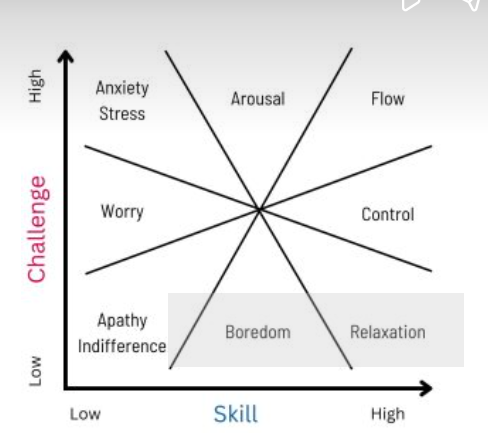
If the challenge is low and your skill is high, you feel bored or relaxed. If boredom is too high, one will conclude the work makes no sense, and they will crave work that feels more meaningful.
If you are moderately skilled and feeling challenged, you are motivated and aroused at work. Productivity rises along with intrinsic motivation[1].
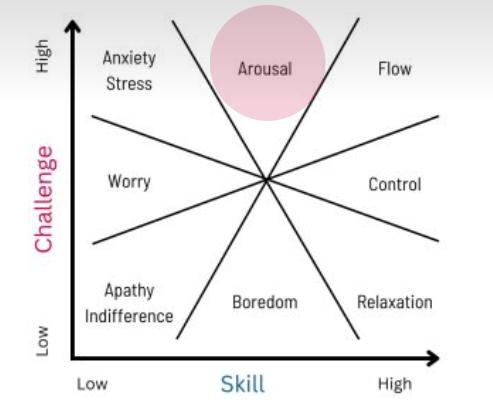
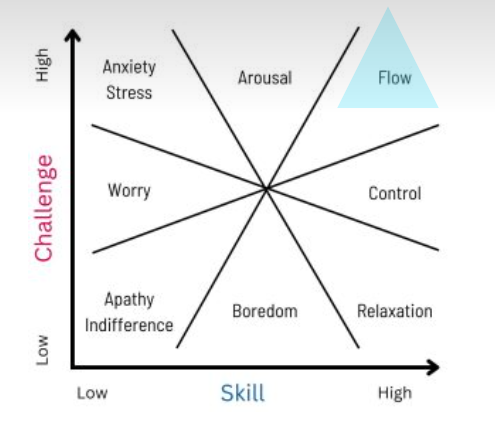
And finally, if you feel challenged at the limit of your capacity and your skill is high, you enter the glorious productive flow state. It is defined as feeling one with the task where you believe you have high skill and are working at the limits of your skill with a slightly higher challenge and sense of purpose.
Paths of 6
The framework I’ve made is about the journey of a worker during a project or a day. It is a path between multiple core emotions and behaviors.
A worker can start at any of the 6 points and journey through different points. The worker may be stuck in a loop between a few points or journey through them dynamically.

- Fight: A worker is aggressively getting something done, is frustrated about a task and obsessing over it, or engaged in a heated conversation with another worker.
- Freeze: A worker is confused, stalling, or doesn’t know what to do or how to respond.
- Flight: A worker is trying to get a task over with, escape a meeting/situation, or gearing to quit.
- Boredom: A worker is idle and unclear about what to do.
- Relaxation: A worker is relaxed, regardless of how the work is going. This would depend on the worker’s skill and challenge at hand.
- Stimulation: A worker is excited about a new project, the completion of a task, fixing a problem, or some form of creativity, learning, or innovation.
All 6 have a good and bad side.
| Emotional state | Good side | Bad side |
|---|---|---|
| Fight | Passionate work, decisiveness, strong decision-making | Unhealthy communication, not thinking from the company’s benefit |
| Freeze | Opportunity to think things through | Inability to communicate, failure at critical moments |
| Flight | Quick turnover of tasks | No confrontation or voicing their opinion, low communication, low output. |
| Boredom | Opportunity to think creatively | Productivity drops and escapism begins |
| Relaxation | Work-life balance, stress is managed, and there is time to think | Getting stuck in a comfort zone |
| Stimulation | Excitement, high productivity, proactive behavior | Distracted by the wrong goal |
Common loops
Fight to Flight: A worker gets stuck between high productivity and avoiding work.
Freeze to Stimulation: A worker, usually when confronted to explain, justify, or answer in the context of a project, is unable to respond, but after some time, they become ready with ideas either to overcome a problem that led to confrontation or an actionable path for progress.
Boredom to Flight: Boredom becomes an annoyance for a worker, and that transitions into escapism. The worker then does what they can to either take on new projects or finish something else.
Fight to Stimulation to Relaxation: A worker aggressively engages, gets ideas, does the work, and feels good about it. Then the cycle repeats after feeling relaxed for a while.
Next steps
After you analyze, you can use this as a company culture-defining tool or a personal assessment of what you want and need! Should be handy for counselors, HR, management, and entrepreneurs.
Look out for information like:
- What is your mood at work saying about your skills and the challenges you face? (XP fluctuation)
- Would you be better off if you upskill or take on more challenging roles? (XP fluctuation)
- Are you stuck in any loop of emotions at work? (paths of 6 model)
- Are employees showing certain behaviors repeatedly that need to change? (paths of 6 model)
Sources

Hey! Thank you for reading; hope you enjoyed the article. I run Cognition Today to capture some of the most fascinating mechanisms that guide our lives. My content here is referenced and featured in NY Times, Forbes, CNET, and Entrepreneur, and many other books & research papers.
I’m am a psychology SME consultant in EdTech with a focus on AI cognition and Behavioral Engineering. I’m affiliated to myelin, an EdTech company in India as well.
I’ve studied at NIMHANS Bangalore (positive psychology), Savitribai Phule Pune University (clinical psychology), Fergusson College (BA psych), and affiliated with IIM Ahmedabad (marketing psychology). I’m currently studying Korean at Seoul National University.
I’m based in Pune, India but living in Seoul, S. Korea. Love Sci-fi, horror media; Love rock, metal, synthwave, and K-pop music; can’t whistle; can play 2 guitars at a time.



























